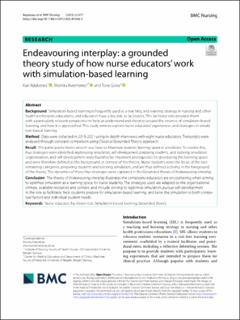Endeavouring interplay: a grounded theory study of how nurse educators’ work with simulation-based learning
Peer reviewed, Journal article
Published version
Permanent lenke
https://hdl.handle.net/11250/3110120Utgivelsesdato
2023Metadata
Vis full innførselSamlinger
- Artikler / Articles [1185]
- Publikasjoner fra CRIStin [1132]
Sammendrag
Background: Simulation-based learning is frequently used as a teaching and learning strategy in nursing and other health professions educations, and educators have a key role as facilitators. This facilitator role provides them with a particularly relevant perspective to help us understand and theorize around the essence of simulation-based learning, and how it is approached. This study aims to explore nurse educators’ experiences and strategies in simulation-based learning.
Method: Data were collected in 2018-2021 using in-depth interviews with eight nurse educators. Transcripts were analysed through constant comparison using Classical Grounded Theory approach.
Result: The participants’ main concern was how to Maximize students’ learning-space in simulation. To resolve this, four strategies were identifed: legitimizing simulation, self-development, preparing students, and tailoring simulation. Legitimisation, and self-development were found to be important prerequisites for developing the learning space and were therefore defned as the background or context of the theory. Nurse students were the focus of the two remaining categories, preparing students and tailoring simulation, and are thus defned as being in the foreground of the theory. The dynamics of these four strategies were captured in the Grounded theory of Endeavouring interplay.
Conclusion: The theory of Endeavouring interplay illustrates the complexity educators are encountering when aiming to optimize simulation as a learning space for nurse students. The strategies used are adapted to the organisational climate, available resources and context, and include striving to legitimize simulation, pursue self-development in the role as facilitator, help students prepare for simulation-based learning, and tailor the simulation to both contextual factors and individual student needs.
Beskrivelse
This article is licensed under a Creative Commons Attribution 4.0 International License, which permits use, sharing, adaptation, distribution and reproduction in any medium or format, as long as you give appropriate credit to the original author(s) and the source, provide a link to the Creative Commons licence, and indicate if changes were made. The images or other third party material in this article are included in the article’s Creative Commons licence, unless indicated otherwise in a credit line to the material. If material is not included in the article’s Creative Commons licence and your intended use is not permitted by statutory regulation or exceeds the permitted use, you will need to obtain permission directly from the copyright holder. To view a copy of this licence, visit http://creativecommons.org/licenses/by/4.0/. The Creative Commons Public Domain Dedication waiver (http://creativecommons.org/publicdomain/zero/1.0/) applies to the data made available in this article, unless otherwise stated in a credit line to the data.

